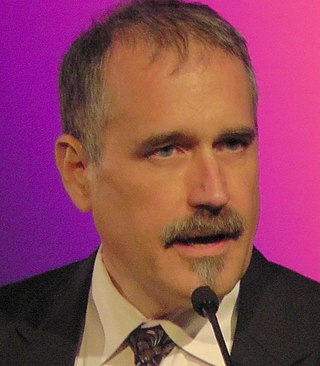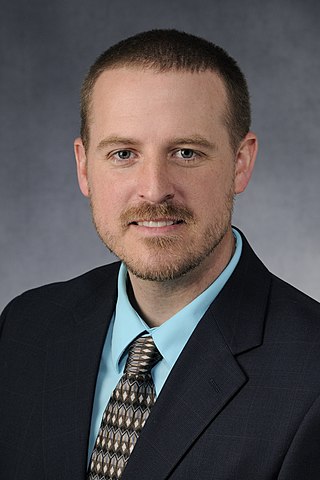Related Research Articles

Thomas Shi-Tao Huang was a Chinese-born American computer scientist, electrical engineer, and writer. He was a researcher and professor emeritus at the University of Illinois at Urbana-Champaign (UIUC). Huang was one of the leading figures in computer vision, pattern recognition and human computer interaction.

Martin Vetterli was president of École polytechnique fédérale de Lausanne (EPFL) in Switzerland, succeeding Patrick Aebischer. He's a professor of engineering and was formerly the president of the National Research Council of the Swiss National Science Foundation.
Ernest Lenard (Ernie) Hall, PhD, PE, is Professor Emeritus of Mechanical Engineering and Computer Science in the School of Dynamic Systems in the College of Engineering and Applied Science at the University of Cincinnati. He was also the Paul E. Geier Professor of Robotics in the Department of Mechanical Engineering at the University of Cincinnati. He has also held joint appointments at the University of Cincinnati with the Department of Electrical and Computer Engineering and Computer Science. He regularly collaborates with faculty and students in other colleges at University of Cincinnati, as well as civic groups, including the FIRST Lego League, the Ohio Academy of Science, and the Society of Manufacturing Engineers. While consulting with the Oak Ridge National Laboratory, he became interested in efforts to make useful robots for some of the dangerous tasks encountered by the Department of Energy, Department of Defense and NASA. He noted the importance of combining image processing algorithms with manipulators and controller to build intelligent robots, especially in automatic target recognition. He has founded and has co-chaired an annual conference on Intelligent Robots and Computer Vision for the past 25 years to provide a forum for new innovations in this field. He sits as the first Paul. E. Geier Professor of Robotics at the University of Cincinnati. At the University of Cincinnati, he established the Center for Robotics Research, which encourages robotics activities in industry, medicine, defense, and even at home with projects like a robot lawn mower. He also founded the UC Robot Team that has participated in the Intelligent Ground Vehicle Competition for the past 15 years and the DARPA Grand Challenge in 2005 and 2007. He has also served as a judge for the Cincinnati FIRST Lego League for two years and has been called the Woodie Flowers of Cincinnati for giving the Gracious Professionalism award. In 2006, Ernest L. Hall won the Grand Prize in the "Made in Express" contest sponsored by Microsoft. His entry for the contest was an all-terrain self-maneuverable robot developed using Microsoft Visual Studio Express. He donated the $10,000 cash prize from the contest back to the University of Cincinnati to support robotics.
Evangelia Micheli-Tzanakou was a professor of biomedical engineering and the Director of Computational Intelligence Laboratories at Rutgers University. Dr. Micheli-Tzanakou was also a Founding Fellow of the American Institute for Medical and Biological Engineering (AIMBE), a Fellow of the Institute of Electrical and Electronics Engineers (IEEE), and a Fellow of the New Jersey Academy of Medicine. Dr. Micheli-Tzanakou's areas of interest included neural networks, information processing in the brain, image and signal processing applied to biomedicine, telemedicine, mammography, hearing aids and electronic equivalents of neurons. Dr. Micheli-Tzanakou received international attention in 1974 when she established the first Brain to Computer Interface (BCI) using her algorithm ALOPEX. This method was used in the study of Parkinson's disease. The ALOPEX algorithm has also been applied toward signal processing, image processing, and pattern recognition. Dr. Micheli-Tzanakou died on September 24, 2012, after a long fight with cancer.

Henrique "Rico" S. Malvar is a distinguished Brazilian engineer and a signal processing researcher at Microsoft Research's largest laboratory in Redmond, Washington, United States. He was the managing director of the lab following the departure of long-time Managing Director Dan Ling in 2007, when he oversaw about 350 researchers. He was a Distinguished Engineer at Microsoft for over 15 years. He retired from Microsoft in January 2023, and later received the title of Microsoft Emeritus Researcher.

Alan Conrad Bovik is an American engineer, vision scientist, and educator. He is a professor at the University of Texas at Austin (UT-Austin), where he holds the Cockrell Family Regents Endowed Chair in the Cockrell School of Engineering and is Director of the Laboratory for Image and Video Engineering (LIVE). He is a faculty member in the UT-Austin Department of Electrical and Computer Engineering, the Machine Learning Laboratory, the Institute for Neuroscience, and the Wireless Networking and Communications Group.
Joseph Wilfred Goodman is an American electrical engineer and physicist.

Nasir Ahmed is an Indian-American electrical engineer and computer scientist. He is Professor Emeritus of Electrical and Computer Engineering at University of New Mexico (UNM). He is best known for inventing the discrete cosine transform (DCT) in the early 1970s. The DCT is the most widely used data compression transformation, the basis for most digital media standards and commonly used in digital signal processing. He also described the discrete sine transform (DST), which is related to the DCT.
George V. Cybenko is the Dorothy and Walter Gramm Professor of Engineering at Dartmouth and a fellow of the IEEE and SIAM.

AlfonsoFarinaFREng is an Italian electronic engineer and former industry manager. He is most noted for the development of the track while scan techniques for radars and generally for the development of a wide range of signal processing techniques used for sensors where tracking plays an essential role. He is author of about 1000 publications. His work was aimed to a synergistic cooperation between industry and academy.
Edmund Y. Lam is a Chinese professor and associate dean of engineering at the University of Hong Kong.

Shannon D. Blunt is an American radar engineer and the Roy A. Roberts Distinguished Professor of Electrical Engineering & Computer Science at the University of Kansas (KU) in Lawrence, KS. He is Director of the KU Radar Systems & Remote Sensing Lab (RSL) and the Kansas Applied Research Lab (KARL).
Maryellen L. Giger, is an American physicist and radiologist who has made significant contributions to the field of medical imaging.

Mona Jarrahi is an Iranian Engineering professor at the University of California, Los Angeles. She investigates novel materials, terahertz/millimeter-wave electronics and optoelectronics, microwave photonics, imaging and spectroscopy systems.

Muyinatu "Bisi" A. Lediju Bell is a researcher and faculty member. She is the John C. Malone Associate Professor of Biomedical Engineering, Electrical and Computer Engineering, and Computer Science at Johns Hopkins University. She is also the director of the Photoacoustic and Ultrasonic Systems Engineering Laboratory.

Moeness G. Amin is an Egyptian-American professor and engineer. Amin is the director of the Center for Advanced Communications and a professor in the Department of Electrical and Computer Engineering at Villanova University.
Jan P. Allebach is an American engineer, educator and researcher known for contributions to imaging science including halftoning, digital image processing, color management, visual perception, and image quality. He is Hewlett-Packard Distinguished Professor of Electrical and Computer Engineering at Purdue University.
Fauzia Ahmad is an associate professor of electrical engineering at Temple University. Her research considers statistical signal processing and ultrasonic guided wave structural health monitoring. She serves as associate editor of the IEEE Transactions on Aerospace and Electronic Systems and Geoscience and Remote Sensing Society. She is a Fellow of the Institute of Electrical and Electronics Engineers and SPIE.
Vishal Monga is an Indian American electrical engineer, researcher and academic. He is a professor of Electrical Engineering at the Pennsylvania State University.
Athina Petropulu is a Greek electrical engineer, researcher and academic. She is Distinguished Professor in the Electrical and Computer Engineering (ECE) Department at Rutgers, The State University of New Jersey. She has made contributions in signal processing, wireless communications and networks, radar systems, etc., and has received many awards and honors in these areas.
References
- ↑ "Teresa Pace Bio". IEEE Aerospace and Electronic Systems Society.
- ↑ "Teresa Pace Profile". SPIE The International Society for Optics and Photonics.